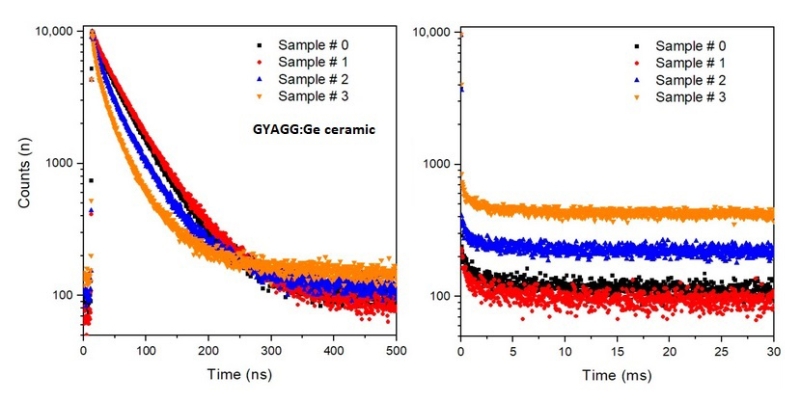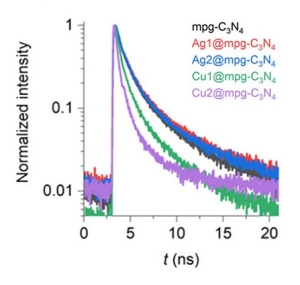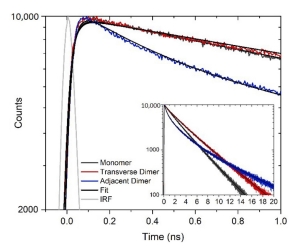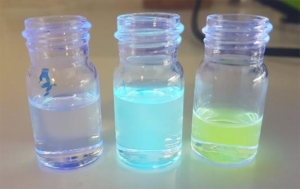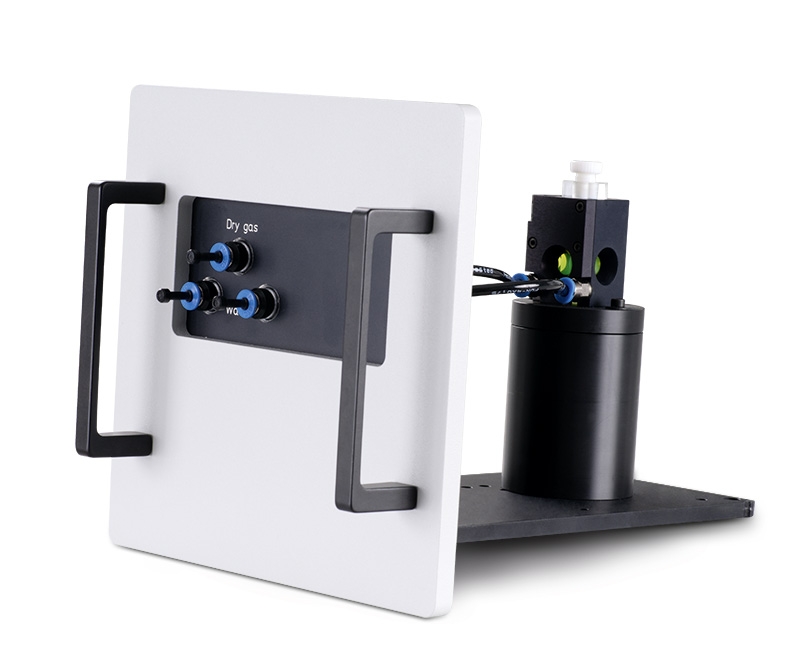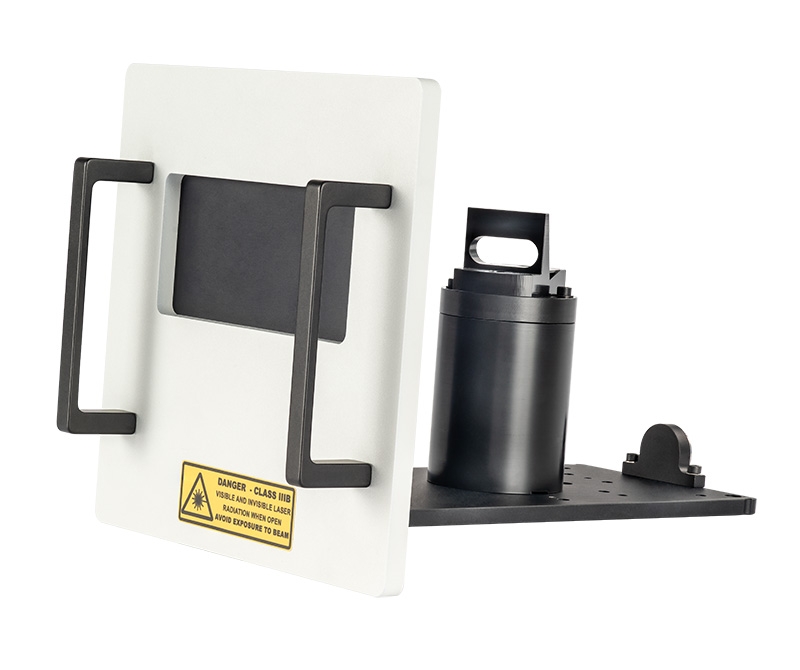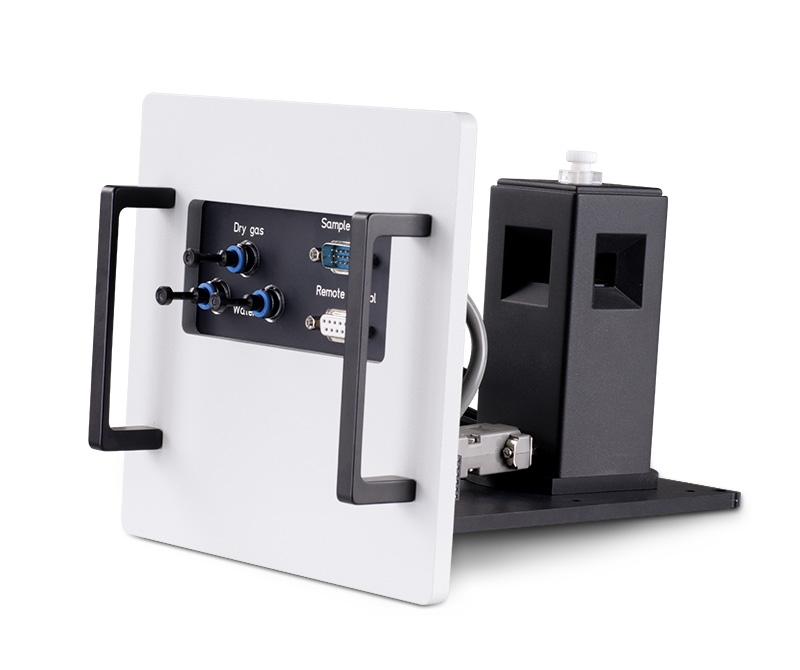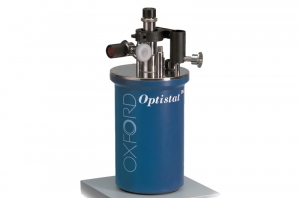Fluorescence Spectrometers
FluoTime 250
Compact Lifetime Fluorometer
- Steady-state in emission and time-resolved (TCSPC, MCS) operation mode
- Easy-handling, compact setup for fast and precise measurements
- Flexible filter-based emission wavelength selection
- Fully automated system for lifetimes ranges from ps to s
- Intuitive acquisition and analysis EasyTau 2 software
Upgrades:
- Micro-photoluminescence upgrade via confocal microscope coupling
- Optional UV-Vis monochromator
- Various sample holders for handling liquid and solid samples with temperature control option
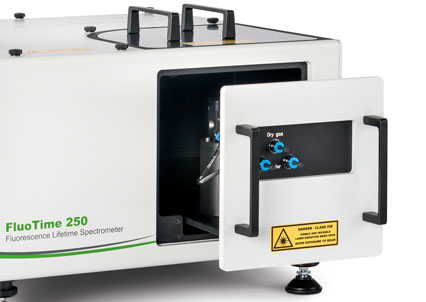 The FluoTime 250 is a compact table-top though flexible lifetime fluorometer for life science, materials science, and photochemistry applications. This setup enables users to carry out routine lab work quickly, reliably and with high precision. Our fully automated setup contains the complete optics and electronics for recording fluorescence and photoluminescence decays by means of Time-Correlated Single Photon Counting (TCSPC) or Multichannel Scaling (MCS) from a few picoseconds to several seconds. FluoTime 250 is filter-based though it can be equipped with an additional monochromator for UV-Vis spectral range. This fluorescence spectrometer offers high spectral and temporal resolution that allow the acquisition and analysis of
The FluoTime 250 is a compact table-top though flexible lifetime fluorometer for life science, materials science, and photochemistry applications. This setup enables users to carry out routine lab work quickly, reliably and with high precision. Our fully automated setup contains the complete optics and electronics for recording fluorescence and photoluminescence decays by means of Time-Correlated Single Photon Counting (TCSPC) or Multichannel Scaling (MCS) from a few picoseconds to several seconds. FluoTime 250 is filter-based though it can be equipped with an additional monochromator for UV-Vis spectral range. This fluorescence spectrometer offers high spectral and temporal resolution that allow the acquisition and analysis of
- Fluorescence Lifetime Decay
- Phosphorescence Lifetime Decay
- Fluorescence Anisotropy
- Time-Resolved Photoluminescence (TRPL)
- Fluorescence Spectra
FluoTime 250 is designed to be equipped with PicoQuant picosecond pulsed light sources. All components are being controlled by EasyTau 2 software. A unique feature of PicoQuant spectroscopy software are its three operation modes:
- Wizard mode provides step by step assistance
- Customized mode enables full control over the instrumental parameters
- Scripting mode allows automation of measurement routines.
The latest version of the software, EasyTau 2.3, supports the integration of Prima and Taiko PDL M1.
Recent publications by researchers using the FluoTime 250
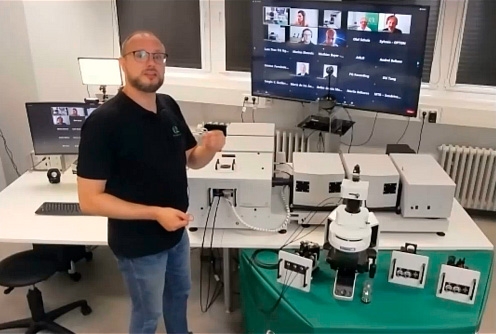 Virtual show day: Closer look at the FluoTime series
Virtual show day: Closer look at the FluoTime series
Our first FluoTime Show Day was held on June 17, 2021. During this virtual event, an in-depth introduction on PicoQuant spectroscopy products was provided by our application specialists. Request the recording and learn how our products can help you in your daily research tasks to carry out steady-state and time-resolved luminescence measurements with a micrometer sized positionable observation volume.
 Course on time-resolved fluorescence
Course on time-resolved fluorescence
PicoQuant annually holds the European short course on "Principles and Applications of Time-resolved Fluorescence Spectroscopy". The course is intended for individuals wishing an in-depth introduction to the principles of fluorescence spectroscopy and its applications to the life sciences. For details see the course website.
| Optical configuration |
L-Geometry |
| Mode of operation |
|
| Sensitivity |
Down to 10 pM measured with a coumarin sample, with excitation at 440 nm and emission detected at 495 nm |
| Lifetime range |
Depending on light source and detector choice |
| Excitation sources |
255 - 1200 nm picosecond pulsed light sources with repetition rates up to 80 MHz |
| Optional monochromator |
|
| Detectors |
|
| EasyTau 2 software |
|
All Information given here is reliable to our best knowledge. However, no responsibility is assumed for possible inaccuracies or omissions. Specifications and external appearances are subject to change without notice.
Sample holders
Fluorescence Measurement of Extremely Dilute Samples
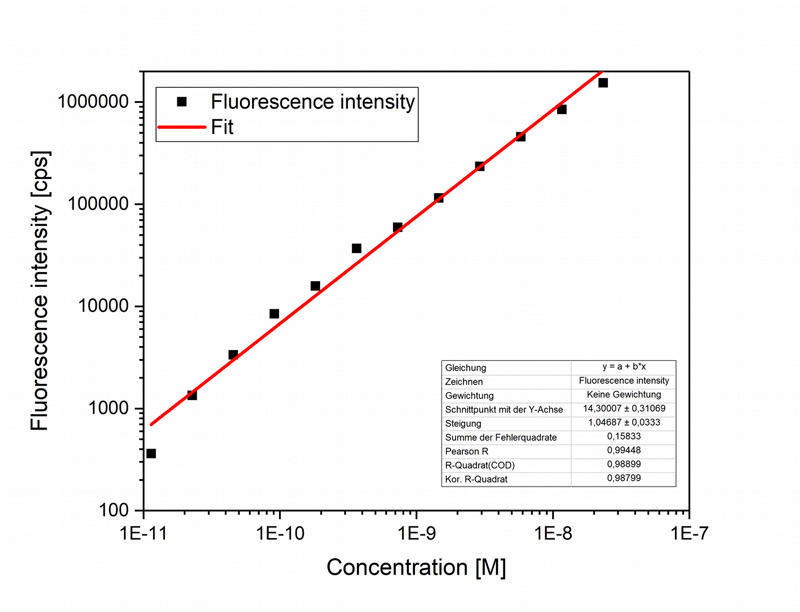 FluoTime 250 provides high sensitivity enabling users to determine fluorescence intensity and lifetime decay of extremely dilute samples with concentration as low as a few pM.
FluoTime 250 provides high sensitivity enabling users to determine fluorescence intensity and lifetime decay of extremely dilute samples with concentration as low as a few pM.
As an example, fluorescence emission of a dilution series of Cumarine 6 in ethanol has been measured at 495 nm utilizing FluoTime 250 and 440 nm excitation laser. The plot depicts a nice linear dependency of count rate on dye concentration down to 20 pM which demonstrate the high sensitivity of the setup.
Dyes and Fluorophors
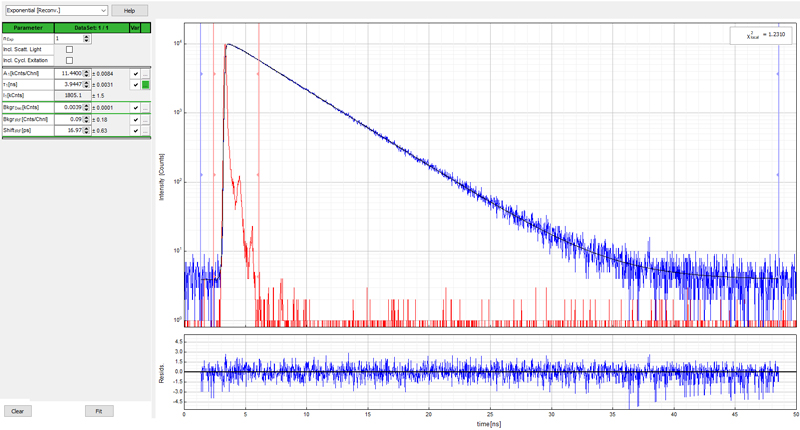 FluoTime 250 is designed for routine lab works and is an optimal setup for fluorescence lifetime measurements of optical probes such as dyes and fluorophores in solution, as powder or thin film.
FluoTime 250 is designed for routine lab works and is an optimal setup for fluorescence lifetime measurements of optical probes such as dyes and fluorophores in solution, as powder or thin film.
As an example, the time-resolved emission of ATTO425 and Ru(bpy)3 aqueous solution are shown. The lifetime decays can be well described with single exponential decay function, as expected. The fit results in 3.944 ± 0.003 ns and 513.85 ± 0.35 ns for ATTO425 and Ru(bpy)3, respectively, which fits well with reported lifetime values for these dyes.
3_in_water.jpg) The samples have been excited at 418 nm using a LDH-P-C-420 pulsed laser. To acquire the long lifetime decay of Ru(bpy)3, burst mode is applied that is a unique feature of PicoQuant pulsed light sources enabling fast measurements. The collected data is analyzed in the fitting module of the EasyTau 2 using a reconvolution tail fit.
The samples have been excited at 418 nm using a LDH-P-C-420 pulsed laser. To acquire the long lifetime decay of Ru(bpy)3, burst mode is applied that is a unique feature of PicoQuant pulsed light sources enabling fast measurements. The collected data is analyzed in the fitting module of the EasyTau 2 using a reconvolution tail fit.
Photocatalysis and Photoelectrocatalysis
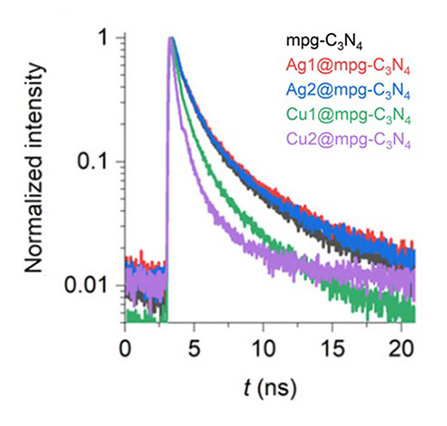 The relation between catalysts texture and their photophysical-photocatalytic properties has been investigated by Liu et al. Employing various methods including transient photoluminescence via FluoTime 250. Time-resolved measurement (TRPL) of single-atom heterogeneous catalysts featuring highly dispersed Ag and Cu on mesoporous graphitic carbon nitride (C3N4) is performed using 365 nm excitation.
The relation between catalysts texture and their photophysical-photocatalytic properties has been investigated by Liu et al. Employing various methods including transient photoluminescence via FluoTime 250. Time-resolved measurement (TRPL) of single-atom heterogeneous catalysts featuring highly dispersed Ag and Cu on mesoporous graphitic carbon nitride (C3N4) is performed using 365 nm excitation.
[ACS Appl. Mater. Interfaces, 2021]
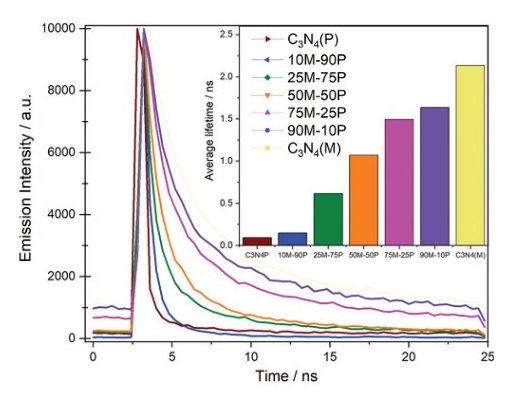 Jerigova et al. applied FluoTime 250 to study sulfur doped carbon nitride (C3N4) as promising material for development of long-range visible catalysts. The transient photoluminescence using 375 nm excitation is acquired from the samples, prepared from various ratio of sulfur-containing precursor, to characterize their physicochemical properties.
Jerigova et al. applied FluoTime 250 to study sulfur doped carbon nitride (C3N4) as promising material for development of long-range visible catalysts. The transient photoluminescence using 375 nm excitation is acquired from the samples, prepared from various ratio of sulfur-containing precursor, to characterize their physicochemical properties.
Characterization of Lasing and Scintillation materials
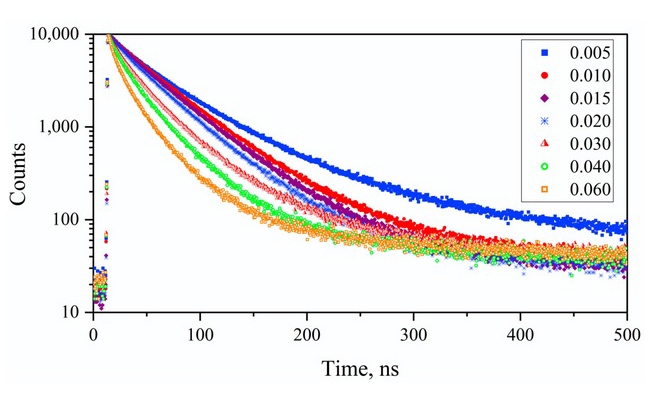 Scintillation materials are being used to detect various ionizing radiation. Korzhik et al. focused on the partial substitution of Gd with Lu ions in the Ce-doped GLAGG crystalline ceramics. They revealed nonequilibrium carriers near various cationic subsystems in the quaternary compound. PicoQuant FluoTime 250 is employed to measure the photoluminescence kinetics using pulsed excitation at 340 and 540 nm. The luminescence was detected at 550 nm with spectral width of 10 nm.
Scintillation materials are being used to detect various ionizing radiation. Korzhik et al. focused on the partial substitution of Gd with Lu ions in the Ce-doped GLAGG crystalline ceramics. They revealed nonequilibrium carriers near various cationic subsystems in the quaternary compound. PicoQuant FluoTime 250 is employed to measure the photoluminescence kinetics using pulsed excitation at 340 and 540 nm. The luminescence was detected at 550 nm with spectral width of 10 nm.
Semiconductors
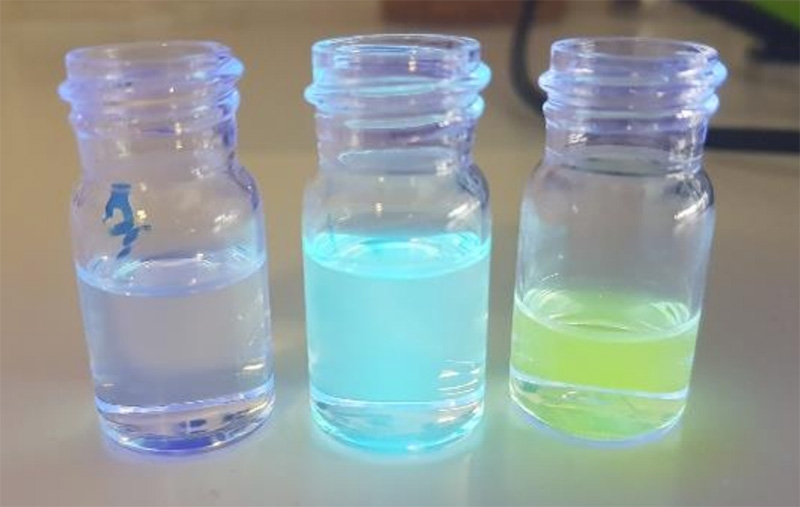 Red carbon is a polymeric semiconductor synthesized from carbon suboxide (C3O2) for potential application in solar cells or photocatalysis. Odziomek et al. Used FluoTime 250 for spectroscopic analysis of red carbon to determine its chemical structure together with elemnetal analysis methods. Three different samples, namely solution, powder and film are characterized resulting in lifetime values of 1.45 ns, 0.09 ns, and 0.07 ns, respectively.
Red carbon is a polymeric semiconductor synthesized from carbon suboxide (C3O2) for potential application in solar cells or photocatalysis. Odziomek et al. Used FluoTime 250 for spectroscopic analysis of red carbon to determine its chemical structure together with elemnetal analysis methods. Three different samples, namely solution, powder and film are characterized resulting in lifetime values of 1.45 ns, 0.09 ns, and 0.07 ns, respectively.
Images are used, adapted and reproduced under CC By licence of each corresponsing journals.
The following documents are available for download:
- Brochure about the FluoTime Series
- Datasheet: FluoTime 250
- Technical Note: Time-Correlated Single Photon Counting (TCSPC)
- Application Note: Microvolume measurements on FluoTime spectrometer
- Application Note: Time-resolved photoluminescence and electroluminescence characterization of a quantum dot LED using the FluoTime 300 spectrometer
- Application Note: Time-resolved Fluorescence Spectroscopy and Microscopy in Materials Science
Latest 10 publications referencing FluoTime 250
The following list is an extract of 10 recent publications from our bibliography that either bear reference or are releated to this product in some way. Do you miss your publication? If yes, we will be happy to include it in our bibliography. Please send an e-mail to info@picoquant.com containing the appropriate citation. Thank you very much in advance for your kind co-operation.





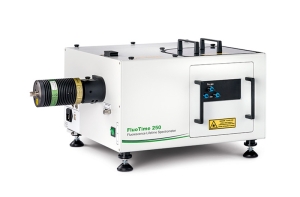
 Contact us
Contact us